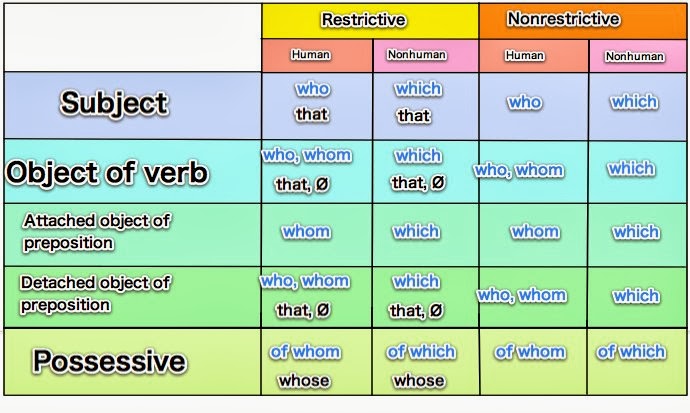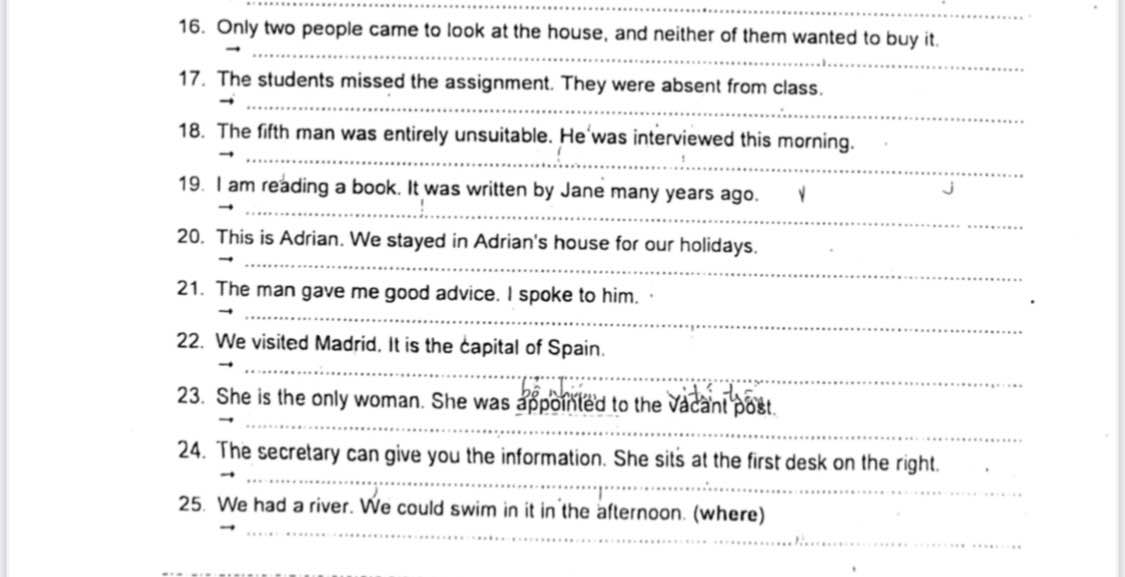Hãy nhập câu hỏi của bạn vào đây, nếu là tài khoản VIP, bạn sẽ được ưu tiên trả lời.

1. The soccer match was exciting. I went to it last Sunday.
……The soccer match which I went to last Sunday was exciting. ……
2. She told me about the trip . She took a trip to England last summer.
……She told me about the trip which she took to England last summer.……
3. I apologized to the woman . I spilled her coffee.
.......I apologized to the woman whom I spilled her coffee...........
4. The people live in Bristol. We are visiting them next week.
………The people who we are visiting next week, live in Bristol. ………
5. We stayed at the Grand Hotel. Ann recommended it to us .
……We stayed at the Grand Hotel where Ann recommended to us………
6. Jane is one of my closest friends . I ‘ve known her for 2 years
……Jane is one of my closest friends whom I ‘ve known for 2 years………
7. The computers are very good . They are made in Holland.
……The computers which made in Holland are very good .……….
8. John is absent from school. His mother is in hospital.
……John whose mother is in hospital, is absent from school. ……..
9. The man is my father . I respect most his opinions.
...The man is my father whom I respect most his opinions..............

6. Mr Brown, who enjoys going to the theatre, has been invited to join our club.
7. Whiting House is an important local monument which was built in 1856.
8. Bono, who is a famous musician, signed autographs at Tower Records yesterday.
9. John F. Kennedy, who was president of the USA, was assassinated in 1963.
10. The Queen will open a new hospital which is in Jarvis Street.

Mệnh đề quan hệ (MĐQH- Relative Clause) là một thành phần của câu dùng để giải thích rõ hơn về danh từ đứng trước nó.
Ví dụ: The girl who is driving this car is my cousin.
Cả cụm từ gạch chân được gọi là MĐQH, để bổ sung nghĩa cho từ “the girl”. Nếu bỏ phần này đi thì vẫn là một câu hoàn chỉnh nhưng chúng ta lại không biết chi tiết về cô gái đó.

|
Các dạng mệnh đề quan hệ |
Cách sử dụng |
Ví dụ |
Chú ý |
|
Đại từ quan hệ |
|
||
|
Who |
Thay thế cho người, làm chủ từ trong MĐQH |
An architect is someone who designs buildings.
|
- Khi who/that đóng vai trò tân ngữ (object) trong mệnh đề quan hệ có thể lược bỏ who/that đi. - Thường dùng “that” hơn là “which” - Trong tiếng Anh ngày nay người ta ít khi dùng “whom” mà thường dùng “who/that” hoặc lược bỏ nó trong trường hợp là tân ngữ object. Lưu ý khi dùng “who/that” ta lại đặt giới từ đi theo sau động từ của nó.
|
|
Which |
Thay thế cho vật, đồ vật. có thể làm chủ ngữ hoặc tân ngữ trong MĐQH |
The book which is on the table is mine.
|
|
|
Whose |
Thay thế cho sở hữu của người, vật ( his- , her- , its- , their- , our- , my- , -’s )
|
I have a friend whose father is a doctor. |
|
|
Whom |
Thay thế cho người, làm tân ngữ trong MĐQH.
|
The man whom I want to seewasn’t here. The girl to whom you’re talking is my friend.
|
|
|
That |
Đại diện cho tân ngữ chỉ người, vật, đặc biệt trong mệnh đề quan hệ xác định (có thể dùng thay who, which) có thể làm chủ ngữ hoặc tân ngữ trong MĐQH |
I need to meet the boy that is my friend’s son |
|
|
Trạng từ quan hệ |
|
||
|
When (in/on which) |
Thay thế cho cụm từ chỉ thời gian : then, at that time, on that day….
|
Do you remember the daywhen we fisrt met ?
|
|
|
Where (in/at which) |
Thay thế cho cụm từ chỉ nơi chốn, có thể làm chủ ngữ hoặc tân ngữ trong MĐQH |
I like to live in a countrywhere there is plenty of sunshine.
|
|
|
Why (for which) |
Thay thế cho cụm trạng từ chỉ lí do : for that reason |
Tell me the reason why you are so sad.
|
- See more at: http://oxford.edu.vn/goc-tieng-anh/hoc-tieng-anh-cung-oxford/ngu-phap-tieng-anh-menh-de-quan-he-relative-clause-625.html#sthash.jaHtDewD.dpuf

1 who lives on the next floor looks very lonely.
That man living on the next floor looks very lonely.
2 who interviewed me
The person interviewing me asked some very difficult questions.
3 that were working on the farm.
I saw some people and some animals working on the farm
4 who answered the phone
The man answering the phone told me you were away.
5 who attended the funeral
Over two hundred people attending the funeral expressed their grief at her son's death.
Cấu trúc mệnh đề quan hệ rút gọn sử dụng Ving: Khi S và V trong mệnh đề quan hệ là dạng chủ động, lúc này lược bỏ đại từ quan hệ và "be"(nếu có) rồi chuyển V chính về dạng Ving.



